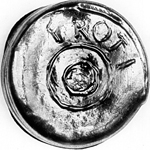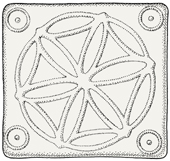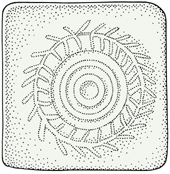Short Range Trade in the Roman World

Barrel-shaped bottle
F.R.O. base impression
Ht., 17.4 cm
From Cany, in France
While mold-blowing as a means of decorating glass had limited success, this technique of glassworking did find extensive use in the production of domestic bottles. During the 1st and early 2nd centuries A.D., most of these bottles mostly were square-sided, but hexagonal and barrel-shaped ones also were reasonably popular as well. Mold-blowing had the practical advantage of assuring uniformity of size along the vessel's length, so replicated sets of them could be packed together, in storage or during transport. Many seem to have been made to hold the standard Roman measure of one sextarius (just over 1.1 U.S. pints).
The bases of most Roman bottles had markings cast into them that comprised either geometric patterns or groups of letters and/or symbols that we assume were abbreviations for personal names, places, or official titles. Once in a while, however, these markings clearly identify the owner of the glass workshop. Thus P. GESSI AMPLIATI links a number of vessels from Herculaneum to an entrepreneurial member of the Gessius family which had strong links to the East through the port of Puteoli. Most other markings on the bases of bottles, jars, and unguentaria are completely ambiguous, however, as to whether they refer to the maker of the vessel or the supplier of its contents for the initial commercial use. If we can draw a parallel from the firm ties between Roman vintners and the makers of pottery amphorae at this time, it may well be that the producer of the bottle's contents sometimes owned a glass workshop as well, so that markings on a bottle's base were a "trademark" for both enterprises.
Many of these bottles went out of circulation for two other reasons, however. Since the Roman view of afterlife was an idealized version of the worldly one, bottles of wine usually were included among the offerings placed in a grave. At the same time, the narrow necks of such bottles were no deterrent to them being used extensively in the western provinces as containers for the cremated remains of deceased relatives (see A Final Resting Place).
Basal markings of FROTI (as above), FRO, FRONTSCF, FRONT SEXTIN, and FRONI are all abbreviations of FRONTINUS, which most likely refers to a major Gallic workshop whose products reached as far afield as northern Britain and the Black Sea coast.

FROTI base impression
From Nimes, in France

Six-petalled rosette
From Conimbriga, in Spain

Wreath of leaves
From Conimbriga, in Spain

Elephant
From Nimes, in France
